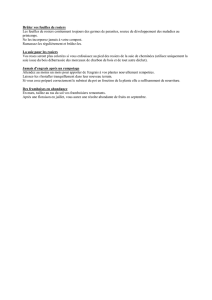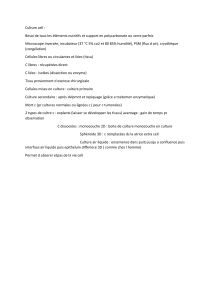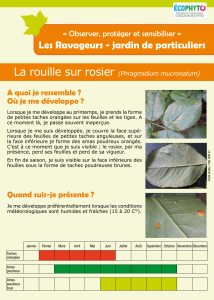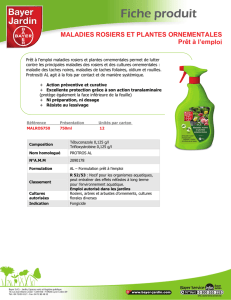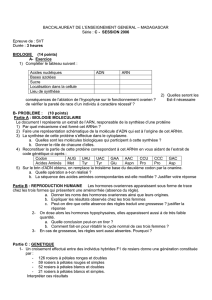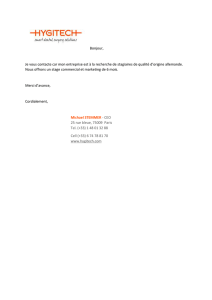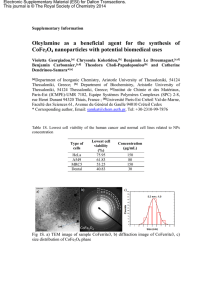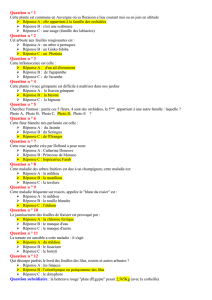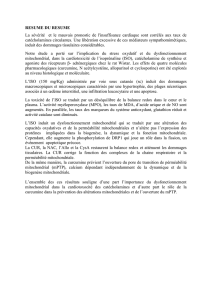Christine Des Rosiers / (Montréal, Canada)
publicité
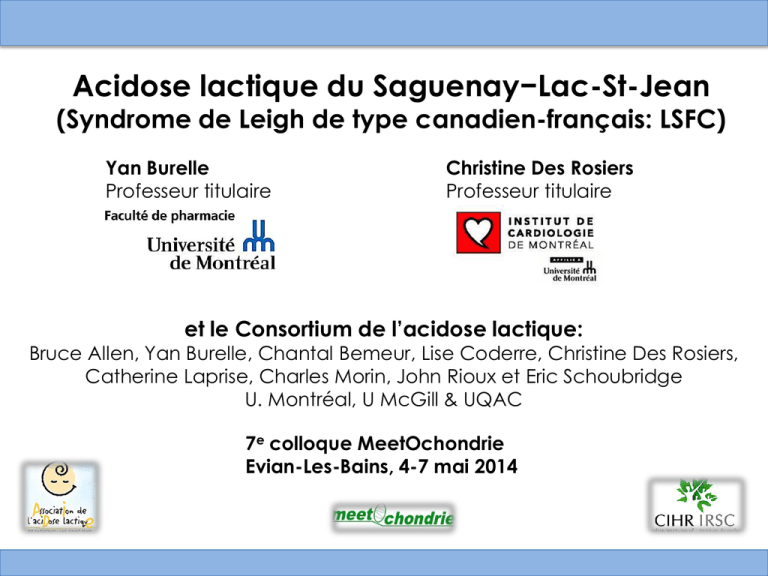
Acidose lactique du Saguenay−Lac-St-Jean (Syndrome de Leigh de type canadien-français: LSFC) Yan Burelle Professeur titulaire Christine Des Rosiers Professeur titulaire et le Consortium de l’acidose lactique: Bruce Allen, Yan Burelle, Chantal Bemeur, Lise Coderre, Christine Des Rosiers, Catherine Laprise, Charles Morin, John Rioux et Eric Schoubridge U. Montréal, U McGill & UQAC 7e colloque MeetOchondrie Evian-Les-Bains, 4-7 mai 2014 Introduction LSFC - Caractéristiques Déficit du complèxe IV: Cytochrome oxydase (COX) VIb Cyt cIV VIa VIII II LRPPRC = leucine-rich pentatricopeptide repeat containing protein VIIb VIc COX III VIIa Vb Va 2H+ ½ O2 Mutations dans le gène LRPPRC H2O •Substitution d’une alanine par une valine (A354V) ↔ 95 % des patients •Délétion de 8 nucléotides (C1277STOP) ↔ un seul patient (hétérozygote composé) •Homologue de la levure (PET309p): protéine liant l’ARNm •Protéine 130 KD •Fonction peu comprise. Merante et al. (1993). American Journal of Human Genetics, 53(2), 481–487. Morin et al. (1993). American Journal of Human Genetics, 53(2), 488–496. LSFC – Caractéristiques cliniques Le LSFC se distingue par des crises d’acidose métabolique, imprévisibles et létales 100 Log rank test, P=0.001 80 Non-LSFC mitochondrial diseases 60 40 LSFC 20 0 0 50 100 150 200 250 300 Age (months) • Crise d’acidose métabolique fulminante avec ou sans crise neurologique • Insuffisance hépatique; atteintes du tronc cérébral • Défaillance multi-organe Debray et al. (2011). Journal of Medical Genetics, 48(3), 183–189. Du gène aux patients: Stratégie de recherche adoptée par le Consortium d’acidose lactique Objectif ultime: • Prédire la survenue des crises • Trouver un traitement raisonnable Samples & Cells Objective 2 - LSFC Model: From gene to function A) Unravel molecular function (E. Shoubridge, MNI) B) Impact on mitochondrial function and cell signaling (Y. Burelle, UM; L. Coderre UM) Biomarkers & Therapies Objective 3 - Biomarker and therapy screening A) Cell-based approaches (C. Des Rosiers, Y Burelle, MHI & UM) B) Metabolomics (C. Des Rosiers, JD Rioux, MHI) Knowledge Transfer Research Program Objective 1 - LSFC Model: From patients to laboratory A) Expand the biobank (C. Laprise, UQAC) B) Create cell and animal model (J.D. Rioux, MHI) CORAMH Clinical Advisor: L. Vachon Patients Coordinator: N. Tremblay Lactic Acidosis Association P. Lavoie President Team Leader: C. Des Rosiers Executive committee: C. Laprise, J.D. Rioux Clinics: Dr. Morin & coll. Structural Organization CIHR EMERGING TEAM GRANT IN LSFC (2009-2014) Résultats récents Molecular role of LRPPRC A354V mutation → normal Lrpprc mRNA level LRPPRC protein content in all tissues (~10% residual) SLIRP (stem-loop interacting binding protein) protein content mitochondrial mRNA’s; = or rRNA Tissue/cell-specific translation defect Severely affected: COX ↓80% Moderately affected: COX ↓ 50% or less Low compensators? High compensators? Sasarman et al. (2010) Molecular Biology of the Cell, 21(8), 1315–1323; (2014). Unpublished results. Impact of LRPPRC mutation on mitochondrial functions Functional outputs • • • • • OXPHOS ROS and Redox homeostasis Ca2+ dynamics Regulation of Cell death … Baseline cellular homeostasis Factors promoting cell death and/or associated to crises Pharmacological interventions • • • • • Nutrients overload Cytokines Catecholamines Oxidants Acidosis Impact of LRPPRC mutation on mitochondrial functions Enhanced fission of the mitochondrial network Normal ATP levels but… Reduced membrane-potential Burelle, Bemeur, Rivard, Morin, Coderre, Des Rosiers & LAC, unpublished results Impact of LRPPRC mutation on mitochondrial functions No signs of enhanced ROS release Impaired OXPHOS capacity Susceptibility to Ca2+-induced permeability transition Burelle et al. unpublished results LRPPRC mutation: Susceptibility to stress-induced cell death Enhanced nutrient-induced cell death in LSFC fibroblasts LRPPRC mutation: Susceptibility to stress-induced cell death Palmitate 1mM DY Cell X CI CII CIII CIV FADH2/NADH Lactate 10mM Glucose Lactate Pyruvate Acyl-CoA & toxic lipid byproducts CV ROS Krebs cycle ATP CPT- I / II Acyl-CoA Succinyl-CoA β-oxidation Acetyl-CoA Mitochondria Cell death (necrosis/apoptosis) LRPPRC mutation: Susceptibility to stress-induced cell death Common features: Promote fatty acid and mitochondrial metabolism • fatty acid uptake • ETC flux • anaplerosis and substrate level ATP synthesis Common features: • Antioxidants Functional impact of LRPPRC mutation Sommaire • Les fibroblastes de patients LSFC présentent plusieurs dysfonctions mitochondriales qui ne compromettent pas la bioénergétique et l’homéostasie cellulaire à l’état basal. • Les fibroblastes LSFC affichent néanmoins une prédisposition à la mort cellulaire induite par le palmitate qui est exacerbée en présence de lactate. • Les résultats suggèrent la présence de stress réducteur Perspectives futures • Transposition aux modèles murins et à d’autres types cellulaires plus pertinents • Évaluation d’autres approches thérapeutiques Biomarker discovery: Metabolomics in LSFC patients Équipe du Consortium: J. Thompson-Legault, V. TremblayVaillancourt, J. Tardif, C. Aubut, J. Landry, G. Boucher, J. Rioux, C. Morin, C. Laprise, C. Des Rosiers Collaborateurs: L. Strittmatter & V. Mootha (Harvard U.); D. Cyr & P. Waters (U. Sherbrooke) Objectif Comparer le profil métabolique des patients LSFC et sujets témoins par une approche métabolomique en vue d’identifier des nouveaux biomarqueurs de la maladie. Metabolomics in LSFC patients Overview of study design LSFC patients (n=9) • Gender Matched controls (n=9) First void urine Matching criteria: • Age (children ± 2 yrs; adults ± 5 yrs) • BMI (children ± 10 percentiles; adults ± 3 kg/m2) • Physical activity level Fasting Smoothie 90 min Smoothie: 9% of daily energy requirements: 0,55 Cal/mL; 42% kcal from carbohydrates, 46% from fat, 12% from proteins Metabolomics in LSFC patients A) Platform 1 - 199 plasma and urine metabolites by GCMS & MS/MS 23 serum compounds (Standard clinical laboratory; fasting only) 3 hormones 24 acylcarnitines 58 organic acids 18 amino acids 15 fatty acids Urine : 58 organic acids (fasting only) (UdeS: Univ. Sherbrooke; MHI: Montreal Heart Institute) B) Platform 2 - 209 fasting plasma metabolites by LCMS/MS 22 organic acids 7 bile acids 19 acylcarnitines 13 aliphatic compounds 13 carbohydrates & conjugates 59 amino acids, peptides & analogues 38 aromatic compounds 8 others 30 nucleosides, nucleotides & analogues (Coll. : V. Mootha, Harvard Univ.) N.B. 47 metabolites were measured on both platforms Metabolomics in LSFC patients Overview of statistical approaches Metabolites measured (fasting condition only): 199 (platform 1) + 209 (platform II) = 408 metabolites (37 had values on both platforms) Quality control filter Principal component analysis (PCA) 293 considere d Permutation test To determine α threshold and false dicovery rate (FDR 10%) (Coll. : G. Boucher & JD Rioux, MHI) Metabolomics in LSFC patients Principal component analysis LSFC patients display a distinct metabolic signature Platform 1 Controls Platform 2 LSFC LSFC (CHet) Metabolomics in LSFC patients Quantitative GCMS analysis of metabolites reflecting NADH/NAD+ Cytosolic Lactate Ratio Pyruvate * * * 3-HB Ratio AcAc * * Mitochondrial Controls Patients Controls Patients Controls *p<0.05; paired t-test and permutations Patients Metabolomics in LSFC patients Sommaire et perspectives • Les patients LSFC présentent une signature métabolique unique. • Les altérations métaboliques identifiées reflètent des perturbations de l’état rédox ( NADH), de l’oxydation des acides gras et du cycle de Krebs. • Analyses additionnelles prévues: échantillons post-smoothie; analyses non-ciblé – lipidomique et composés hydrosolubles. • Utilité de cette signature: Suivi de la progression de la maladie et de l’impact de traitements potentiels. • La signature métabolique des patients LSFC est-elle spécifique ? Peut-on l’extrapoler aux autres maladies mitochondriales ? Perspectives futures Leçons et perspectives futures • Extension à court terme: Études en cours - Modèles de souris: Caractérisation du phénotype (Y. Burelle, E. Shoubridge & J. Rioux) - Modèles cellulaires: Flux métaboliques et voies de signalisation de survie (C. Des Rosiers , C. Bemeur & L. Coderre) - Métabolomique: Analyses additionnelles, non ciblées sur l’urine et le plasma avant et après smoothie (C. Des Rosiers) • Recherche de financement • Expansion du modèle d’étude au-delà du LSFC - Recherche de collaborateurs et partenaires Remerciements Membres du Consortium d’acidose lactique Consortium • Photo du consortium Membres actifs: B Allen, C Beauchamp, C Bemeur, Y Burelle, G Charron, L Coderre, A Cuillerier, S Deschênes, C Des Rosiers, S. Hoarmand, C Laprise, P Lavoie, C Morin, Y Mukaneza,, M-E Rivard, JD Rioux, F Sasarman, EA Shoubridge, J Tardif, N. Tremblay, J Thompson Legault & V Tremblay-Vaillancourt Collaborateurs: F. Labarthe, B. Maranda, L. Vachon, V. Mootha, L. Villeneuve. Pierre Lavoie, Président, Association de l’Acidose lactique
